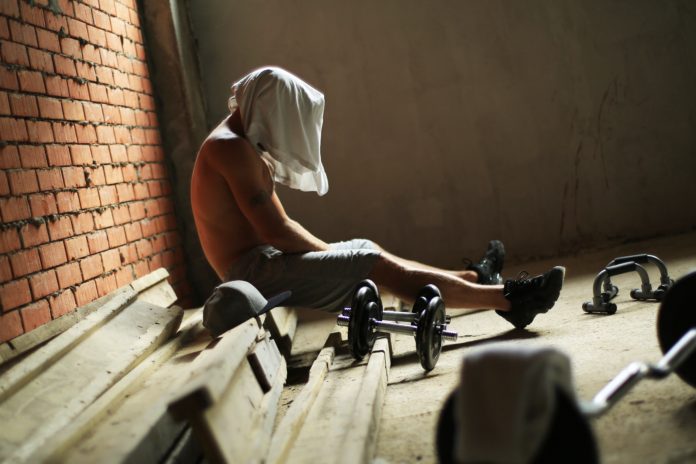TRAINING & FITNESS
3 Moves to Improve Your Deadlift
Much like the bench press is the ultimate test of upper body power for most general lifters and the squat is the standard in the world of powerlifting, the deadlift is what strongman athletes pay the most attention to.
Published
5 years agoon
By
fitinstyle
Much like the bench press is the ultimate test of upper body power for most general lifters and the squat is the standard in the world of powerlifting, the deadlift is what strongman athletes pay the most attention to. In the eyes of many, the man or woman who can pick the most weight up off the floor and stand tall with it is the strongest. It’s that simple.
Outside of that, the deadlift is a total body movement that can help you get stronger, bigger, and better. So you should pay attention to it. As a matter of fact, I would suggest you make it a focal point in your training as soon as possible.
That doesn’t mean you should necessarily do that and nothing else but you should focus on lifting more weight by doing exercises that can specifically help you. These three accessory movements are all very influential in how you perform the traditional deadlift.
Deficit Deadlift
Some lifters struggle from the floor to the knees so this one might appear weird to do but it will help. You stand on a plate or box while the bar and weight remain on the floor. Improving how you lift a weight a greater distance will help you get stronger when it comes to doing the regular version. Your hamstrings, glutes, and even your lats are all challenged when you do this. Obviously you won’t do as much weight but the goal is to focus on execution with the weight you can lift. You should hold the bar with the same grip that you perform the regular deadlift with.
Rack Pull
This one is for the second half of the deadlift. If you get stuck at the midpoint and have trouble locking out, this is the remedy. Now the rack pull gets a bad rep because of how some guys will do this because they can add more plates to the bar and it appears more impressive. They’re working their egos more than their muscles and that helps no one.
If you start with the bar at around your knees and focus on pulling the weight up with conviction while lowering it under control (without banging it), then your lower back and traps will feel the effects. You should also focus more on moving the hips forward so you lock out and stand tall. I don’t object to straps being used here but do what you can with your natural grip strength before you put the straps on.
Bent Over Barbell Row
This is a move that is considered an upper body lift that targets the upper back. So why should you do it to improve your deadlift? Think about when you’re pulling the bar up. Your upper back and lats are crucial in stabilizing the weight and pulling it to that midpoint where you begin the lockout. So ultimately, a strong upper back means a strong deadlift. You should also feel this in your arms which isn’t necessarily a bad thing.
I know lots of guys deadlift with a mixed grip and you might think it would be a good idea to do that here. You should either go with a double under grip or double over grip. Don’t do a mixed grip with this because it could lead to injury with either arm since your elbows are bending and you’re pulling the weight in. Straps here would be a good idea too so you can focus more on pulling and less on the grip fatigue.
Sample Deadlift Workout
Deficit Deadlift – 5 sets of 3 reps with 50-60% of your 1RM.
Rack Pulls – 3 sets of 5 reps.
Bent Over Barbell Row – 3 sets of 8 reps.
You may like
TRAINING & FITNESS
Working The Transverse Ab Muscles
Most abdominal exercises target the rectus abdominus and the vertical abdominals, ignoring the transverse abdominals. Even crunches, the staple of most abdominal workouts, do nothing for the transverse abdominals.
Published
4 years agoon
March 10, 2020By
fitinstyle
A group of muscle mass that usually will get uncared for in abdomen train routines are the transverse abdominals, the core muscle mass that lie under the rectus abdominus. Most stomach workout routines goal the rectus abdominus and the vertical abdominals, ignoring the transverse abdominals. Even crunches, the staple of most stomach exercises, do nothing for the transverse abdominals. These muscle mass are literally crucial to focus on, nevertheless, as they connect with each the decrease again muscle mass and the rectus abdominus and for a girdle for all the stomach. Any routine aimed toward flattening the abdomen ought to embrace the transverse abdominals as a spotlight. Utilizing the next workout routines, you may work out your transverse abdominals and actually make progress on that flat tummy. As with all exercise routine, make sure to seek the advice of an expert earlier than starting and at all times heat up correctly to keep away from harm.
This abdomen train requires mendacity in your again on a flat floor, reminiscent of the ground or a bench. Use a mat or towel to cushion your backbone. Bend your knees in order that your ft are flat on the ground. Elevate your pelvis (and solely your pelvis) off the ground, maintain momentarily, after which decrease it again down. Repeat for a whole set. Sustaining a managed motion is essential to this train. This may will let you use your stomach muscle mass, slightly than your physique’s momentum, to do the work on the train. Additionally, make sure to hold your higher physique on the ground all through.
Crunchless Crunch
This primary train is pretty easy however may also be pretty troublesome. Primarily, it includes attempting to tug the stomach button in in the direction of the backbone. This may be difficult, because it includes utilizing muscle mass which you is probably not used to activating. To begin, both lie or in your abdomen or kneel. You would possibly need to strive each methods and see which helps you are feeling the train higher. Calm down your physique as a lot as potential, then attempt to use solely the decrease abdominals to maneuver your stomach button towards your backbone. Maintain for ten seconds. If holding for ten seconds feels straightforward, maintain for an extended interval. The objective is to carry the contraction till you both can not really feel it, otherwise you really feel different muscle mass working tougher than the transverse abdominus. Whenever you really feel this, let the contraction out.
Scissor Kicks
This abdomen train additionally requires mendacity on the ground. Place your arms below your butt, conserving your again pressed towards the ground. Slowly increase one leg to a top of about ten inches, then slowly decrease it again to the ground. As your decrease one leg, increase the opposite. Repeat this movement for a whole set. Sustaining management all through is essential, not permitting momentum to get the higher of you. Your higher physique ought to stay on the ground by way of all the transfer.
There are many different workout routines concentrating on the transverse abdominals, however these three should be sufficient to get you began. Abdomen workout routines like these are key to any tummy-flattening plan, and they’re particularly good for pregnant and post-partum girls.
Associated Posts
TRAINING & FITNESS
Training to Failure Every Set… Pathway to New Muscle or Pathway to Overtraining?
Published
4 years agoon
February 1, 2020By
fitinstyle
Seven Time Mr. Olympia Arnold Schwarzenegger said in the movie Pumping Iron, “Muscle growth does not take place until the repetitions are taken past the point of failure.” There have been many great Olympians such as Dorian Yates and Ronnie Coleman that took every set to complete muscular failure. Many people have the notion that you are not hardcore if you are not training to failure every set to complete muscular failure, and most trainers and athletes have advocated that repetition to failure is an essential characteristic of resistance training regimens.
To date there is only a single exercise study reporting training to failure may lead to greater increases in strength and hypertrophy. Two studies had caused controversy in the resistance training research realm when experimental groups were matched for total work; isometric force production, single repetition maximum strength, local muscle endurance, and explosive power gains were similar regardless of whether the sets were taken to complete muscular failure or not. Some researchers have advocated that taking every set to total failure leads to long-term overtraining, which may be counterproductive to muscle growth. There has not been a training to failure study for some time, so researchers decided to investigate the subject once again. The purpose of the study was to compare the increases in muscular strength, size, and neural activation between three resistance training programs in which the participants always trained to muscular failure or predominantly not to muscular failure. 28 previously untrained males, who first undertook a 4-week period of standardized resistance training to muscular failure before being designated as either high or low responders, were then randomly allocated into different groups. All groups performed a 12-week resistance training program comprised of four sets with 85% of 1RM for the bicep curls, training three times per week. One group trained to complete exercise failure while the other group did not.
At the end of the study, the researchers reported that although all the groups increased muscular strength in the arms, there were no significant differences between groups. Similarly, they reported that although all groups increased muscle size in the arms, there were no significant differences between groups.
Training to Failure Increases Cortisol Production Post-Exercise
The newest study has reported that training to failure can lead to elevated cortisol levels for 48 hours after exercise. Researchers examined post-exercise anabolic effects after two resistance training (bench press and squats) workouts:
-performed either close to muscular failure, 12 repetitions to failure with 70% of 1RM
-Performed further away from muscular failure, three sets of 6 repetitions (Not to Failure)
The researchers reported that training to failure resulted in greater increases in cortisol (measured immediately post-exercise), and markers of muscle damage (creatine kinase were elevated 48 hours post-exercise). Training to failure led to a lower bar speed compared to not training to failure when measured up to 24 hours post-exercise for the bench press (65% reductions in bar speed after training to complete failure versus 26% reduction in bar speed after non-training to failure), and up to 6 hours for the squat (44% reduction after training to failure versus 20% reduction after not training to failure). Training to failure also led to a lower jump height compared to not training to failure when measured up to 48 hours post-exercise. This study shows that the mechanical, neuroendocrine and autonomic cardiovascular response is markedly different when manipulating the number of repetitions per set. Halving the number of repetitions in relation to the maximum number that can be completed serves to minimize fatigue and speed up recovery following resistance training.
Training to complete muscular failure results in increased cortisol productions and delayed muscle recuperation. If you do train to failure, then you may need to train less often or try keeping your reps lower as the study did. Based on the research, training to failure each workout may lead you on the pathway to overtraining.
TRAINING & FITNESS
When Training to Failure Can Hurt You
“Training to failure resulted in greater neuromuscular fatigue and longer muscle recuperation than the not training to failure group for 48 hours”
Published
5 years agoon
November 6, 2019By
fitinstyle
If you go into any gym or college training facility, you will see athletes pushing themselves to the limit. In order for an athlete to achieve greatness, he or she must push themselves to the limit, but there is a time when an athlete must pull back to avoid over training.
The body much like a race car, the body needs regular maintenance, if you hit the nitro button on the car too much, your going to burn out the engine. One of the easiest way of hitting the nitro button too much is by training to complete muscular failure each set. Training to muscular failure has been proposed to lead to greater gains in muscular strength and size because of greater neural drive when training at a closer proximity to muscular failure, implying that more motor units may be recruited.
While failure can be a valuable tool in a bodybuilder’s training routine, there is some evidence to indicate that it comes with a significant cost.
Previous research has found that training to failure every set significantly increased resting levels of the catabolic hormone cortisol and suppressed anabolic growth factors such as IGF-1. This study demonstrated that taking every set to failure could lead to overtraining and a catabolic response. This study may indicate that bodybuilders who take every set to absolute failure may put themselves at risk of impeding long-term growth.
In one 12–week study, the researchers found no difference in the routines that were taken to failure and those that were not. This study only lasted 12 weeks, so long term effects of taking every set to absolute muscular failure is not known. Training to failure too frequently can a possible lead to over training, as previously reported with the study that training to failure resulted in greater increases in cortisol and decreased IGF-1 levels. A new study published in the International Journal of Sports Medicine reports that training to failure each set needs longer recuperation than those not training to failure.
This study analyzed the time course of recovery following two resistance exercise protocols differing in level of effort: maximum (to failure) vs. half-maximum number of repetitions per set.
Researchers had a group of volunteers perform 3 sets of bench presses and squats.
Nine males performed either:
3 sets of 8 reps (80% 1RM) to failure
3 sets of 4 reps (80% 1RM) not to failure.
Training to failure resulted in greater neuromuscular fatigue and longer muscle recuperation than the not training to failure group for 48 hours. This indicates it takes a longer time for full muscle recovery following intense resistance exercise that is taken to failure compared with a similar workout where sets are terminated before failure is reached. Future studies should be conducted to determine how fatigue extent influences MUs recruitment and RT-related muscle adaptations on strength trained and untrained individuals.
Some research question the scientific validity of training to failure each set. For example, using trained participants train to failure and the other group train just short of muscular failure. At the end of the study, both group increased muscular strength and muscle mass equally, with no differences between the groups. It seems that when volume is equated between groups, it does not matter whether a person trains to failure or not to failure.
Researchers wanted to test the validity of training to failure vs. not training to failure in a series of different training methods.
Researchers had one group perform:
5 sets of 5 reps (Not Training to Failure).
25 reps in as few sets as possible (Muscular Failure).
Under both workout conditions, they had 2 minutes rest between sets (2 seconds concentric, 1 sec isometric, 2 seconds eccentric). The training load and training volume were both the same. The The training protocol to failure required ~7 minutes and 6 seconds to complete, whereas the training protocol not to failure 5×5 protocol required 12 minutes and 10 seconds to complete.
The study suggests that, when training just short of muscular failure using a 5×5 approach, may attain similar strength increases when compared to training to complete muscular failure. When volume is matched, both protocols produced the exact same increases in strength but training to failure appears a more time-efficient protocol.
“Training to failure resulted in greater neuromuscular fatigue and longer muscle recuperation than the not training to failure group for 48 hours”.
Related Article
Recent Posts
- The Ultimate Guide to Berberine: Unlocking Its Health Benefits and Healing Properties
- The Ultimate Guide to Berberine: Unleashing its Health Benefits for Blood Sugar Control, Weight Management, and More
- The Ultimate Guide to Berberine: How This Natural Compound Can Revolutionize Your Health
- The Ultimate Guide to Berberine: Unlocking Its Powerful Health Benefits for a Healthier You
- Exploring the Health Benefits of Berberine: A Natural Remedy for Diabetes, Cholesterol, and More
Advertisement
Sponsored Ads
TRENDING
-

 HEALTH & WELLNESS5 years ago
HEALTH & WELLNESS5 years agoAcidophilus: A Probiotic Bacterium
-

 herbs3 months ago
herbs3 months agoThe Ultimate Guide to Ashwagandha Extract: Stress Relief and Optimal Health Unveiled
-

 HEALTH & WELLNESS4 years ago
HEALTH & WELLNESS4 years agoHerbs and Essential Oils to Fight Coronavirus
-

 TRAINING & FITNESS5 years ago
TRAINING & FITNESS5 years ago6 Ways to Decrease your Shoulder Pain!
-

 HEALTH & WELLNESS5 years ago
HEALTH & WELLNESS5 years agoWhy Muscles Get Sore
-

 DIET & NUTRITION5 years ago
DIET & NUTRITION5 years agoLow Carb Diet: Carbohydrates Influence on Testosterone
-

 Fitness5 years ago
Fitness5 years ago“No Pain, No Gain” True or Just a Fitness Myth
-

 HEALTH & WELLNESS5 years ago
HEALTH & WELLNESS5 years agoThe Best Shoulder Workout in Only Six Moves

